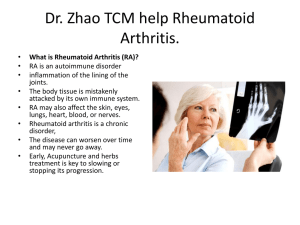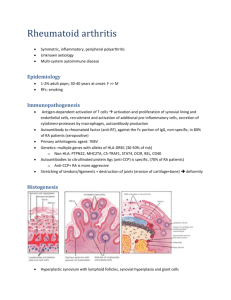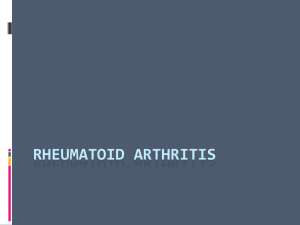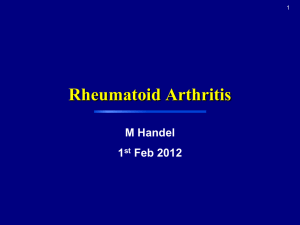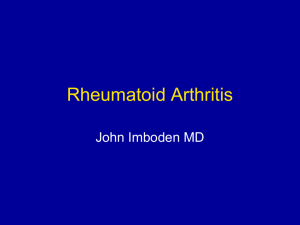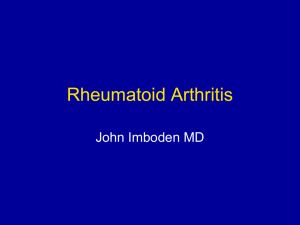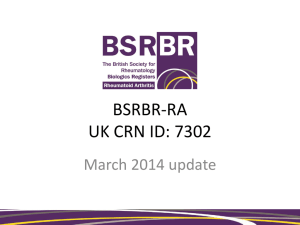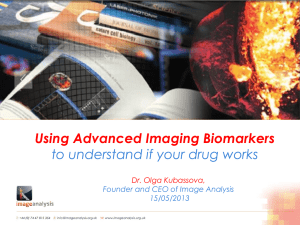Rheumatoid Arthritis by Dr Sarma
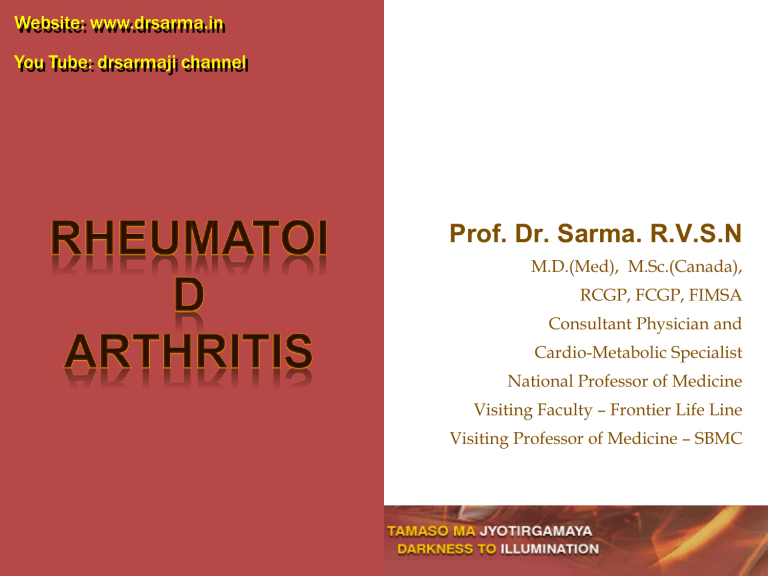
Website: www.drsarma.in
You Tube: drsarmaji channel
Prof. Dr. Sarma. R.V.S.N
M.D.(Med), M.Sc.(Canada),
RCGP, FCGP, FIMSA
Consultant Physician and
Cardio-Metabolic Specialist
National Professor of Medicine
Visiting Faculty – Frontier Life Line
Visiting Professor of Medicine – SBMC
BioEd Online
Rheumatoid Arthritis (RA): Definition
Progressive, systemic, Autoimmune inflammation
Often aggressive, devastating consequences
Unknown etiology (auto immune, ?infection, smoking )
Characterized by
Symmetric synovitis – Chronic Polyarthritis
Joint erosions, cartilage and bone destruction
Multisystem - extra-articular manifestations
Onset usually slow & insidious over months
In 15 to 20% may have rapid or acute
Aggressive management leads to good control
2
Rheumatoid Arthritis (RA): Epidemiology
Prevalence of - 0.8% to 2.1% of the population
Gender predilection ratio – Women: Men – 3:1
Prevalence increases with age – Juvenile RA
About 40-60% have severe disease – 3 fold mortality
Median life expectancy is shortened by 3 to 7 years
Onset mostly between ages of 35 – 60 years
Genetic – HLA-DR1( 1*0101, 0401) – Class II HCA
Exact etiology is not known
3
Cost of RA versus CAD
Direct costs
Indirect costs
Total costs
Costs per patient in $ per year
RA CAD
3790
2735
6525
7929
1051
8980
4
Immunology
5
6
Rheumatoid Arthritis: Pathogenesis
Current
Treatment
Targets
T cell
B cell
Antigenpresenting cells
B cell or macrophage
Pannus
Synoviocytes
IFN-
& other cytokines
Rheumatoid
Factors, anti-CCP
Macrophage
TNF
IL-1
Immune complexes
Complement
Neutrophil
Chondrocytes
Mast cell
Osteoclast
Articular cartilage Production of collagenase and other neutral proteases
Bone
Adapted from Arend WP, Dayer JM. Arthritis Rheum. 1990;33:305 –15
7
Immunology of RA
8
Imbalance in Mediators – Chronic Inflammation
9
The Mediators of Joint Destruction
Chemokines
IL-1, IL-6
Cytokines
TNF
MMP
VEGF
Immune destruction
10
The Natural Course of RA
Undifferentiated
Polyarthritis
Early RA – Mild
Disease
Severe RA with
Deformities
11
Time Line of Function Loss in RA
Moderate loss of function
Severe loss of function
Very severe loss of function
0 2 5
Years from onset of symptoms
10
25% require surgical Rx.
Wolfe F, Cathey MA. J Rheumatol. 1991;18:1298-1306.
12
Rheumatoid Arthritis: Diagnosis - ACR Criteria
Four or more of the following criteria must be present:
Morning stiffness > 1 hour
Arthritis of > 3 joint areas of the possible 28 joints
Arthritis of hand joints (MCPs, PIPs, wrists)
Symmetric swelling (arthritis) – same joints on both sides
Serum rheumatoid factor – RA Factor (antibody to IgG)
Rheumatoid nodules
Radiographic changes
First four criteria must be present for 6 weeks or more
13
Rheumatoid Arthritis: Typical Involvement
Wrist joints and MCP joints - very commonly involved
Index and middle Metacarpophalangeal joints
Proximal interphalangeal joints (PIP)
Metacarpophalangeal joints (MCP)
Metatarsophalangeal joints (MTP)
Elbows, Shoulders
Knees, Ankles, Hips. Lumbosacral area is not involved
Spine: only Atlanto-axial joint (C1– C2), subluxation
Terminal interphalangeal (TIPS) joints are not involved
14
The Joints Involved in RA
15
DAS28 (Disease Activity Scoring) for RA - EULAR
Calculated using a formula that includes
Counts for tender and swollen joints – (28 joints)
General health by the patient (on a scale of 0 to 100)
A measurement of ESR or CRP
Score > 5.1 – High disease activity,
Score 5.1 to 3.2 – Moderate disease activity
Score < 3.2 – Low disease activity
Score < 2.6 – Being in Remission
Response to Rx. – of ≥ 1.2 – Good and < 0.6 – Poor
European League Against Rheumatism (EULAR )
16
Rheumatoid Arthritis – ACR Functional Classes
Classification Specifications of activity levels
Class I
Class II
Class III
Class IV
Complete ability to perform daily activities self-care, vocational and avocational
Ability to perform usual self-care and vocational activities; limited avocational activities
Ability to perform usual self-care activities; limited vocational or avocational activities
Limited ability to perform usual self-care or vocational or avocational activities
17
Extra Articular Manifestations of RA
Systemic involvement Special Features
Musculoskeletal wasting
Tenosynovitis, Bursitis
Osteoporosis, Rh nodules
Vasculitis, Arteritis
Pericarditis, Myocarditis
Episcleritis, Scleromalacia
Pleural effusion, Nodules
Cervical cord compression
Mononeutitis, carpel tunnel
Felty’s syndrome, Caplan’s
18
19
20
Swan-Neck and Boutonniere Deformities in RA http://images.rheumatology.org
– Album of American College of
Rheumatology
21
22
23
Radiological Changes in Rheumatoid Arthritis
24
Erosion of the Odontoid process Atlanto-Axial subluxation
25
Blood Parameters in RA
Acute Phase Reactants (APR )
C-Reactive Protein (CRP) - > 4 mg% -
It is the single most useful marker
ESR is raised > 30 mm – other confounders
Ceruloplasmin
Haptoglobin (Hp)
Leukocytosis, Nutrophilia
Normocytic normochromic anemia
Thrombocytosis
26
Synovial Fluid in RA
No need in general for joint aspiration
Required to exclude other causes of arthritis
Inflammatory arthritis picture
Turbid fluid with reduced viscosity
Increased protein content
Decreased glucose content
WBC count from 2,000 to 50,000/ l
PMNLs predominate
Total compliment, C3 and C4 are markedly
27
Rheumatoid Factor (RA Factor)
Developed by Eric Waller in 1937 – Rose Waller Test
Agglutinating Abs - Latex particle agglutination assay
Isotype specific enzyme immunoassays – New technique
Antibodies to Fc portion of our own IgG - These Abs are IgM
Positive in 5% of normal persons and in only 70-80% of RA
Low specificity (false +ves) & low sensitivity (false –ves.)
It is not a screening or Dx. tool – More a prognostic tool
It is negative in 30% cases of RA – Sero negative RA
RF are commonly seen other disease – see next slide
28
Positive Rheumatoid Factor is seen in:
Disease
Advanced Rheumatoid Arthritis
Rheumatoid Arthritis (over all)
Sjögren's syndrome
Systemic Lupus Erythematosis (SLE) 30%
Sub acute bacterial endocarditis (SABE) 40%
Tuberculosis
Old Age
Normal healthy individuals
15%
20%
5%
Frequency
100%
70%
90%
29
Anti-CCP Antibody Test in RA (ACPA)
Antibodies to Cyclic Citrullinated Peptides (anti-CCP)
Similar sensitivity for RA (70%)
Specificity for RA (>95%) better than RA Factor
In early polyarthritis anti-CCP are useful for Dx.
Anti-CCP are associated with more severe disease
They spell a poor prognosis and rapid progression
They may be positive in asymptomatic patients years before the onset of symptoms
30
Serology in Rheumatoid Arthritis
Test
RA Factor is IgM Antibody to the Fc portion of the IgG
Anti CCP: Antibodies to Cyclic Citrullinated Peptides
31
Differential Diagnosis of RA
Connective tissue diseases - Scleroderma and SLE
Fibromyalgia, Palindromic Rheumatism
Infectious endocarditis, Acute Rheumatic Fever
Poly articular gout
Polymyalgia Rheumatica
Sarcoidosis, Hemochromatosis
Sero negative spondylo arthropathies
Reactive arthritis - evaluate for psoriasis, Reiter’s, IBD
Still’s disease, Thyroid disease, Viral arthritis
32
Rheumatoid Arthritis v/s Osteoarthritis
Feature
Pathology
Rheumatoid Arthritis Osteoarthritis
Autoimmune Degenerative
Age Any age – usually 35+ Increases with age
Joints involved Small joints MCP, PIP Large joints, TIP
Spine (Axial) C1-C2 - Subluxation Lumbosacral
Extra articular Many systemic effects Few systemic effects
Course
Disability
Rapidly progressive
Highly disabling
Slowly progressive
Mild to moderate
33
Early Progression of Bone Erosions in RA
34
Rheumatoid Arthritis: Predictors of Prognosis
Presence of > 20 inflamed joints
Markedly elevated ESR
Radiographic evidence of bone erosions
40%-85% of RA pts unable to work in 8-
Presence of rheumatoid nodules
Higher class of functional disability
Persistent inflammation; comorbidities
Advanced age of onset
Low socio-economic status, low education level
HLA-DR *0401 or DR *0404
35
Rheumatoid Arthritis: Complications
Carpal tunnel syndrome,
Baker’s cyst, Subcutaneous nodules,
Systemic Vasculitis,
Sjögren’s syndrome,
Peripheral neuropathy,
Cardiac and pulmonary involvement,
Felty’s syndrome, and anemia
Risk of lymphomas three times greater
Risk of infection due to disease and treatment
36
Goals of Therapy
1.
2.
6.
7.
3.
4.
5.
Relief of pain
Reduction of inflammation
Protection of articular structures
Maintenance of functional activity
Control of systemic involvement
Slow the progression of disease
Increase the over all quality of life
37
Non Pharmacological Management
Rest
Exercise
Flexibility/stretching
Muscle conditioning
Cardiovascular/aerobic
Diet
Weight management
Physical and occupational therapy
38
Therapeutic Window of Opportunity
Erosive changes occur early in disease
Even a brief delay of therapy can have a significant impact on disease parameters years later
Early DMARD treatment to arrest progression
MTX is the sheet anchor – Combination of DMARDs
Bridge the gap initially with NSAID and GC
Biologics only for refractory case – with caution; cost
Surgical treatment options in selected patients
O’Dell JR. Arthritis Rheum. 2002;46:283-285.
Van der Heijde DM. Br J Rheum. 1995;34 (suppl 2):74-78.
Therapeutic Window of Opportunity
Erosive changes occur early in disease
Even a brief delay of therapy can have a significant
impact on disease parameters years later
Surgical Treatment will be mandated in
Early DMARD treatment to arrest progression
25%
MTX is the sheet anchor – Combination of DMARDs
Bridge the gap initially with NSAID and GC
Biologics only for refractory case – with caution; cost
Surgical treatment options in selected patients
O’Dell JR. Arthritis Rheum. 2002;46:283-285.
Van der Heijde DM. Br J Rheum. 1995;34 (suppl 2):74-78.
Medical Management – Drug Classes
Classes NSAIDs – Cox-1 & Cox-2 inhibitors
Glucocorticoids – Prednisolone, MP
IAS – Intra articular steroids
DMARDs – MTX, SSZ, HCQ, CQ
Immunosuppressive Rx.– AZT, Leflunomide, CS
Cytotoxic agents – Cyclophosphamide
Biologics – TNF- antibodies, IL-1 R antagonist
Old drugs – Gold salts, D-Penicillamine
41
NSAIDS in RA
NSAIDs
COX 1
Constituent pathway
Renal and GI homeostasis
COX2
Inducible pathway
Inflammation
Selective COX 2 Inhibitors
Improved GI tolerability
Reduced effects on RBF
No effect on platelets
Called as COXIBs
May have adverse effect on heart
Celecoxib
Etoricoxib
Meloxicam
42
NSAID Class of Drugs
Non Selective
Ibuprofen
Ketoprofen
Diclofenac
Aceclofenac
Piroxicam
Lornaxicam
Naproxen
Indomethacin
NSAIDs used as analgesics
Ketorolac
Aspirin (NSAID)
Selective COX-2
Celecoxib, Etoricoxib
Meloxicam
Analgesics
Tramadol
Paracetamol
43
Pros and Cons of NSAID Therapy
PROS
Effective control of inflammation and pain
Effective reduction in swelling
Improves mobility, flexibility, range of motion
Improve quality of life
Relatively low-cost
CONS
Does not affect disease progression
GI toxicity common
Renal complications
(eg. Irreversible renal insufficiency, papillary necrosis)
Hepatic dysfunction
CNS toxicity
44
Pros and Cons of Corticosteroid Therapy
PROS
Anti-inflammatory and immunosuppressive effects
CONS
Does not conclusively affect disease progression
Can be used to bridge gap between initiation of DMARD therapy and onset of action
Intra-articular steroid (IAS) injections can be used for individual joint flares
Tapering and discontinuation of use often unsuccessful
Low doses result in skin thinning, ecchymoses, and
Cushingoid appearance
Significant cause of steroidinduced osteopenia
45
Methotrexate (MTX)
MTX is given 10 to 30 mg orally, IM, or SC per week
It is DHF reductase inhibitor – Supplemental folic acid
The clinical improvement takes one to two months
Nausea, diarrhea; mouth ulcers; rash, alopecia; Abnormal LFT
Rare: low WBC & platelets; pneumonitis; sepsis; liver disease;
EBV related lymphoma;
CBC, creatinine, and LFTs monthly for six months, then every one to two months; repeat AST or ALT in two to four weeks if initially elevated, and adjust dose as needed;
Rapid onset (six to 10 weeks); tends to produce more sustained results over time than other DMARDs and lowers all-cause mortality;
Can be used when cause of polyarthritis uncertain;
Often combined with other DMARDs like Leflunomide, SSZ, HCQ
46
Changing Paradigm of Treatment
Current Treatment
Traditional DMARDs
• Early
Aggressive Rx.
• Biological
• Combination treatment
47
48
49
New Treatment Paradigm for RA
Orthopedic surgery
Occupational therapy
Physical therapy
Patient education
Weaver AL, 2008.
Higher dose steroids for flares or extraarticular disease
Intraarticular steroids
Simple analgesic
50
Biological Agents in RA
TNFα antagonists
Adalimumab (Humira)
Etanercept (Enbrel)
Infliximab (Remicade)
Interleukin-1 antagonist
Anakinra (Kineret)
Suppressors of T-Cell activation
Abatacept (Orencia)
Anti B-Cell monoclonal antibody
Rituximab (Rituxan)
51
Characteristics of Biologicals used in RA
Etanercept
Enbrel
Infliximab
Remicade
Adalimumab
Humira
Anakinra
Kineret
Abatacept
Orencia
Target
Half Life
TNF
3-5 Days
TNF
8-10 Days
TNF
10-20 Days
IL-1
Receptor
4-6 Hrs
T-Cell
Activation
13-16
Days
Rituximab
Rituxan
B-Cell
19 Days
Construct Human Chimeric Human Human Human Chimeric
Dosing
Route
Once
Biweeklyweekly
Sub-Cut
Once every
4-8 weeks
Once every
1-2 weeks
I.V.
Sub-Cut
Once
Daily
Sub-Cut
Once
Monthly
I.V.
Twice every 6-12 months
I.V.
52
Biologics: Relative Contraindications
Active Hepatitis B Infection
Multiple sclerosis, optic neuritis
Active serious infections
Chronic or recurrent infections
Current neoplasia
History of TB or evidence of Koch’s
Congestive heart failure (Class III or IV)
53
Safety Considerations of Biologicals
Serious Infections
Opportunistic infections
(TB)
Malignancies/lymphoma
Demyelination
Hematologic abnormalities
Administration reactions
Congestive heart failure
Hepatic
Autoantibodies and drug induced lupus
Vaccination
54
www.drsarma.in
BioEd Online
